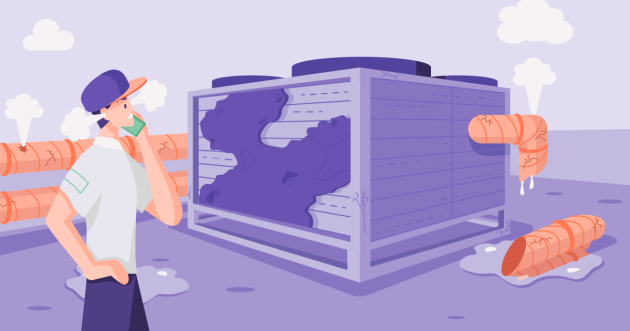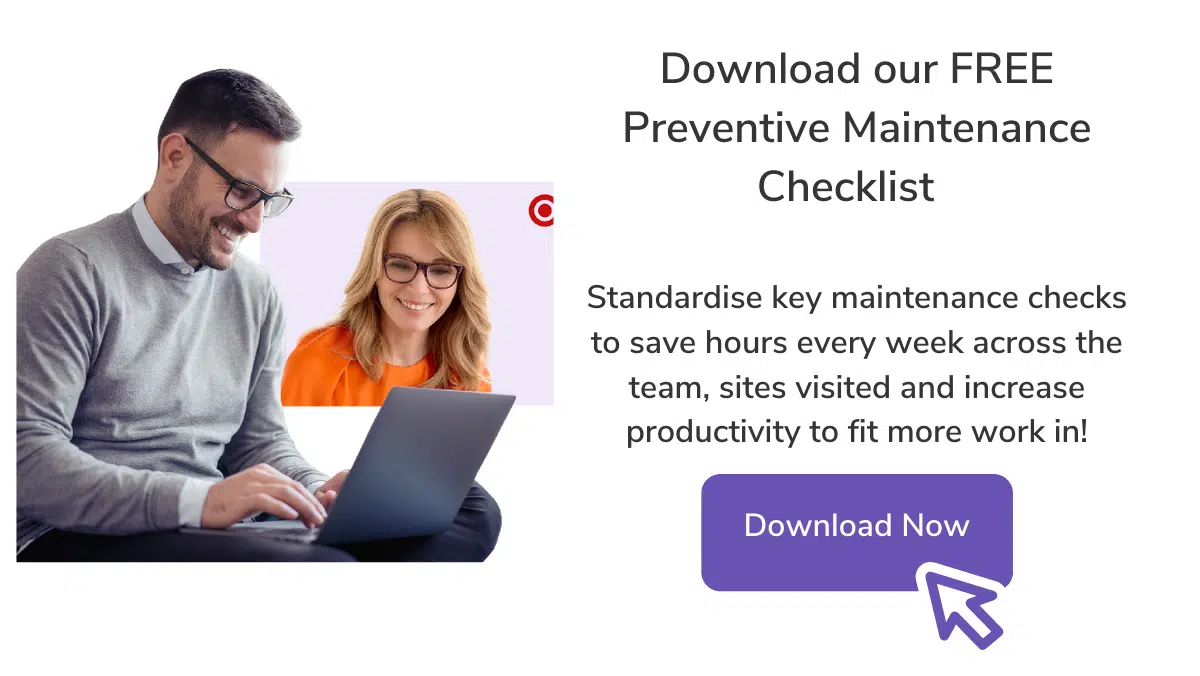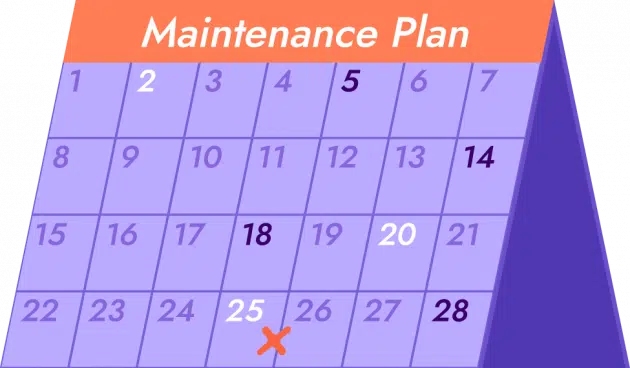Building & Facility Maintenance Checklist (Commercial Building Template Included)
What is Building and Facility Management?
Do you want your maintenance management to run like a well oiled machine? Are you struggling to keep your technicians on track in the field? For businesses in the asset and field management industry, facility management is a key part to ensuring longevity, helping business continuity and becoming more cost effective by reducing hefty repair bills.
Facility maintenance is the activity untaken in commercial buildings to ensure high productivity and safety are maintained on site. Building or facility maintenance can include anything to do with equipment maintenance, building systems or infrastructure.
While facility management seems like a simple practice in theory, it can become a daunting task including core business operations such as; scheduling, organising technicians, managing budgets, keeping up to date with client data and ensuring the productivity of the core business operations and maintenance stays in line with the manufacturer’s warranty requirements. Facility management can include both hard FM and soft FM operations to help manage your long term asset goals.
One of the best ways to reduce your stress and boost consistency in your workflow, is with a great job management software and maintenance checklist.
The Importance of Facility & Building Maintenance Checklist
A building maintenance checklist is an invaluable tool for facility managers. Regular maintenance not only helps in keeping the building in top shape but also helps in avoiding costly repairs that can occur due to neglect. It ensures the safety of the occupants, prolongs the lifespan of the building, and contributes to a more sustainable and efficient operation.
How to Create a Building Maintenance Checklist
Creating a building maintenance checklist involves a thorough understanding of the building’s systems and components. Here are some steps to guide you:
- Identify Key Systems and Components: Start by identifying the key systems and components that require regular maintenance. These may include HVAC systems, electrical systems, plumbing, roofing, and structural elements.
- Determine Maintenance Tasks: For each system or component, determine the maintenance tasks that need to be performed. This could range from simple tasks like cleaning to more complex tasks like system checks and repairs.
- Set a Maintenance Schedule: Based on the maintenance tasks, set a schedule. Some tasks might need to be performed more frequently than others.
- Assign Responsibilities: Assign each task to a specific person or team. This ensures accountability and that no task is overlooked.
Seasonal Maintenance Tips
Seasonal maintenance is an important aspect of building upkeep. Here are some tips:
- Spring: This is a good time to check the building’s exterior for any damage caused by winter weather. Check the roof, clean the gutters, and inspect windows and doors for any leaks that might have developed.
- Summer: Focus on the HVAC system to ensure it’s ready for the hot weather. Check the cooling system and replace air filters.
- Fall: Prepare for the colder months. Check the heating system and ensure that all windows and doors are properly sealed.
- Winter: Regularly check for ice dams and icicles, as they can cause damage to the roof and gutters. Also, ensure that the heating system is working properly.
Facility Maintenance Checklist by Industry
Facility maintenance changes in each industry, where different demands and expectations need to be met. Facility management per industry could look something like this:
1. HVAC Equipment Maintenance
A typical HVAC inspection at a facility can involve units from air conditioner, ventilation, heat pumps, or furnaces. Inspections can include:
- Inspect correct airflow from HVAC unit
- Clean drains
- Replace air filter
- Clean coils
- Inspect refrigerant levels
- Visually inspect wires
- Check thermostat
2. Fire Equipment Maintenance
Facility maintenance for fire protection equipment can involve fire extinguishers, fire alarms, exit signs, smoke detectors and any fire fighting equipment. Inspections can include:
- Check expiry date on fire extinguishers
- Ensure fire extinguishers are in the correct location
- Check smoke alarm batteries
- Ensure exit signs are clearly displayed
- Ensure exit doors are not obstructed
- Ensure sprinkler systems are working properly
3. Heavy Equipment Maintenance
For heavy equipment maintenance, your inspection checklist will vary depending on the type of equipment including heavy equipment such as dozers, excavators, loaders, rollers, cranes, compactors, and backhoes. For more insight into equipment, you will need to refer to your user or manufacturer’s manual.
For examples of pre-start checklists, see our blog on Heavy Equipment Preventive Maintenance Checklist Template.
4. Civil/Construction Equipment Maintenance
Facility maintenance for civil or construction equipment maintenance will also vary depending on the type of equipment you have. For example a checklist for every 500 hours usage checklist, you might find your construction equipment checklist looks like:
- Check for leaking hydraulic lines
- Inspect hydraulic oil level
- Check hydraulic system
- Replace hydraulic filters
- Check engine coolant levels
- Check engine oil
- Inspect belt driven components
- Fluid analysis
- Check electrical lines
- Check fuel delivery system
- Inspect fuel lines
- Check brake lights including parking brake
- Insect valve stems
- Inspect economical operation of asset
- Assess voltage retention
- Visual inspection of lift arms
- Check battery’s age
- Update service records with results
Facility Management Checklist Requirements
For facility and building maintenance, a thorough checklist can improve safety, smooth out scheduling, increase consistency and boost productivity in your business. With a facilities management checklist in your business, you will find that your workflow runs more smoothly and your technicians become more effective in the field. Here are the top 5 things you need to know to build your maintenance checklist…
1. Structure your facilities management plan
The first step in creating your facilities management checklist, is to set up your preventative maintenance plan. The best way to avoid repair costs and constant breakdowns is to have a detailed preventive maintenance plan in place in your workflow. You will first need to address what aspects of your facilities management need to be considered in your preventive plan.
Not all parts of your facility management will need to be considered in your maintenance scheduling and you should arrange your maintenance program around first those with the highest priority.
To ensure that all your facility and equipment maintenance meet your maintenance standards, you should next take a look at your manufacturer’s warranties.
2. Know your recommendations
When you begin to create your facilities checklist and maintenance plan you need to know your manufacturer’s recommendations. Performing work without adhering to these recommendations can easily lead to you voiding your warranty and ending up with a pile of legal fees and repair costs.
These recommendations for your facility and equipment management will also help you determine what your maintenance schedule and checklist will look like. Your warranty will specify the exact dates and frequencies you need to know in order to schedule your facility management efficiently.
3. Build your core business procedures
Once you have defined what does and doesn’t need to be included in your maintenance plan, you can build your procedures. In order to have a smoothly flowing checklist, you need to organise your maintenance activities. To do this you need to ensure that you have clear and coherent instructions for your technicians that involve the correct PPE and safety measures.
For your preventive plan, you will need to build your procedures to include any tools, equipment or spare parts that you might need. You will also find that when building your checklists and procedures that you might need to update after some trial and error. You won’t always get your planning right the first time and a little adjustment may be needed.
4. Keep a thorough documentation of your facility management
A key part of your building and facility maintenance will include a thorough documentation process. Without clear methods to update and access information while in the field, you can leave your technicians in the lurch.
For facility management in the construction or commercial, a thorough documentation will also help ensure that you build an easy to access client history and help identify key points in your asset history. Imagine if next time you have a breakdown or issue, you could refer back to your asset history and get all the answers you need without the frustration.
5. Reassess management facility history
Another key part to your facility management is reviewing your asset management. The purpose of improving emergency preparedness in the physical workplace helps to ensure the correct solutions are in place. Companies may find that their asset history has no clear department or long term processes and operations.
The importance of asset history for future emergency breakdowns and safety systems will help save time and identify trends. When you review and assess your asset history, you gain helpful insight into common asset patterns. In doing this activity can save you both time and money. With the review of your assets, you will see what parts of your maintenance process are redundant and what parts could be linked to trends that involve breakdowns.
A typical Facility & Building Maintenance Checklist
Commercial facility management maintenance is a broad field that varies significantly from site to site. It depends on the specific equipment and tools present, the nature of the work conducted within the facility, and the unique needs of the people using the space. Property management for facilities managers can encompass a wide range of tasks related to the people, place, and process within the built work environment.
Here’s a more detailed look at a typical facility management checklist for a commercial building:
- Clean & Inspect HVAC Ducts: HVAC systems are crucial for maintaining a comfortable environment within the building. Regular cleaning and inspection can help ensure optimal performance, improve air quality, and prevent costly repairs or replacements.
- Replace Air Filters in HVAC Units: Air filters play a key role in maintaining the efficiency of HVAC systems and improving indoor air quality. They should be replaced regularly, typically every 1-3 months, depending on the type of filter and the building’s specific needs.
- Replace Batteries in Smoke Alarms: Smoke alarms are essential for safety. Their batteries should be replaced at least once a year to ensure they’re always operational. It’s also a good practice to test smoke alarms monthly.
- Replace Water Filters: If the building has a water filtration system, the filters should be replaced according to the manufacturer’s recommendations. This helps ensure clean, safe drinking water and prolongs the life of the filtration system.
- Service Fire Alarm: Regular servicing of the fire alarm system is crucial for safety. This includes testing the system, inspecting all components, and ensuring the system is compliant with local fire codes.
- Replace Light Globes: Regularly replacing light globes ensures optimal lighting conditions, which can enhance productivity and safety. It’s also an opportunity to switch to more energy-efficient lighting options, if not already in use.
- Upload Data to Service Provider: If the building uses smart systems or IoT devices, regular data uploads can help service providers monitor system performance, identify potential issues, and provide proactive maintenance.
- Inspect Electrical Systems: Regular inspections can identify potential electrical issues that could pose a safety risk or disrupt operations. This includes checking for damaged wires, testing circuit breakers, and ensuring all outlets are functioning properly.
- Plumbing Inspections: Regularly inspect plumbing systems to identify leaks or other issues early. This includes checking pipes, testing faucets and toilets, and inspecting any appliances connected to the water supply.
- Building Exterior and Grounds Maintenance: Regularly inspect the building’s exterior and grounds. This includes maintaining landscaping, cleaning exterior windows and surfaces, inspecting roofing, and ensuring walkways and parking lots are in good condition.
Remember, this is a general checklist and might need to be customized based on the specific needs and requirements of your facility. Regular maintenance is key to extending the life of your facility’s systems and ensuring a safe, comfortable environment for all occupants.
The role & responsibilities facility managers
For a facility manager there will be two types of jobs that need to be carried out for hard FM and soft (FM) management facilities; strategic and operational. You ideally want your facilities manager to boost business continuity within your environment with the purpose to increase asset performance and health and safety in the workplace.
Facility managers need the support of software systems and real time technology to become efficient in both the office and the field. Without the correct functions, a facility manager may struggle with physical paper based systems that don’t accurately track costs, security or functions of your built environment.
Duties for a commercial HVAC building or business will include repairs, maintenance and client management. Some tasks that a facility manager can include; fire safety management, air conditioning maintenance, plumbing, energy or water services and health and safety within the built environment.
How to keep your building & facility management system on track
You may find that structuring your facility management checklist is an overwhelming process and you have no clear direction. With the help of an automated software, you can access all the information you need from the office or the field with project management and a higher quality of life for your assets.
Do You Have an Organizational Function Which Integrates People, Place and Process?
With facilities management software like FieldInsight, you gain access to an all-in-one system that ensures that your team stays on the same page. With the ability to create checklists, customise reports and track employees in the field, FieldInsight allows you to gain more power over the daily operations in your business and access budgeting and job statuses to keep you on track.
FieldInsight provides access to the five primary automations so your business has all the tools it needs to succeed. To learn more, get started with a demo today and talk with one of our product specialists.
What You Should Do Now
- Book a Demo. You’ll be in touch with an automation expert who has worked in this space for over 5 years, and knows the optimal workflow to address your needs.
- If you’d like access to free articles about managing HVAC workflows, go to our blog.
- If you know someone who’d enjoy reading this page, share it with them via email, Linkedin, Twitter, or Facebook.





